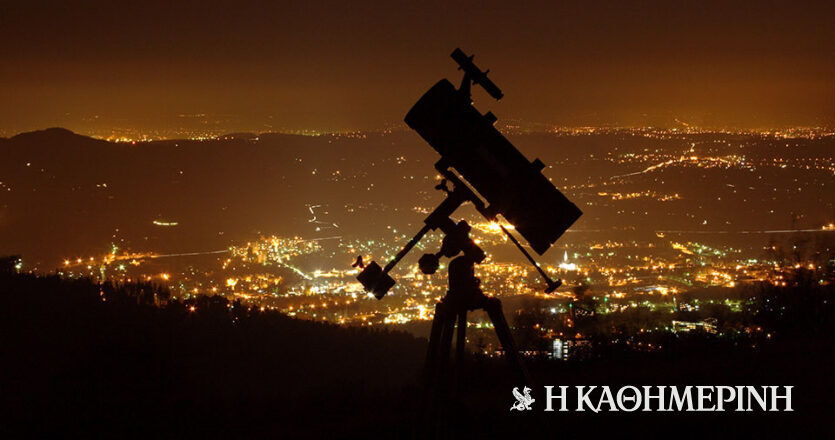
People all over the world see fewer stars in the sky with each passing year.
Observations by professional and amateur scientists around the world in recent years have revealed a disturbing trend: the stars in the night sky are getting harder to see due to the rapid increase in light pollution.
A new scientific study finds that before our very eyes, often without us realizing it, stars are disappearing at an impressive — or rather, alarming — rate.
One in three people around the world no longer see the stars
The change in star visibility corresponds to an approximately 10% annual increase in the brightness of the night sky over the past decade. This means that a child who was born in some area, there were 250 visible stars, today on the same site after 18 years he can observe a maximum of 100 stars, that is, more than half of them have already become “invisible”.
The naked eye should be able to see several thousand stars in a clear dark sky. Unfortunately, it’s estimated that about 30% of people around the world — roughly one in three — have already lost their view of our galaxy due to light pollution, and the problem is only getting worse, according to new research.
Researchers of the international science project Globe at Night, led by Christopher Kimba of the German Research Center for Geosciences (GFZ) in Potsdam and Ruhr-University Bochum, who presented Published in the journal Sciencedata from 2011 to 2022 were analyzed which included a total of 51,351 naked-eye observations of stars by humans at about 19,300 sites in different countries, mostly in Europe (3,700) and North America (9,500).
Double the brightness of the night sky
It is estimated that the brightness of the night sky has doubled in less than eight years. The annual increase in luminosity, which ranges from about 7% in Europe to 10% in the United States, is much larger than that (about 2% per year) relative to the increase in artificial light based on satellite radiation measurements.
This is mainly because satellites measure light pollution, mainly recording light directed towards the sky, while citizens are mainly affected by horizontal light pollution, which is the largest.
In many inhabited areas of the Earth, the night sky does not completely darken, as there is a diffuse glow of artificial light in the atmosphere.
This light pollution makes it difficult to observe the stars at night. The spread of LED lighting, which emits more blue light to which the eyes are more sensitive, has exacerbated the situation.
In addition, light pollution disrupts the natural cyclic transition from the sun to starlight and back, a natural process by which biological organisms (including humans themselves) have evolved.
Studies in the past have highlighted the ecological effects of artificial lighting, including for animals and insects, but also more generally for the ecosystems of Europe and other regions, as well as for human health.
Source: RES-MPE
Follow kathimerini.gr on Google News and be the first to know all the news
See what’s new News From Greece and the World, in kathimerini.gr
// INITIAL ANALYTICS setTimeout(function () { (function (d, s, id) { var js, fjs = d.getElementsByTagName(s)[0]; if (d.getElementById(id)) return; js = d.createElement(s); js.id = id; js.async = true; js.src = "https://www.googletagmanager.com/gtag/js?id=G-JJJ7LY7JGM"; fjs.parentNode.insertBefore(js, fjs); }(document, 'script', 'ga-1'));
window.dataLayer = window.dataLayer || [];
function gtag() { dataLayer.push(arguments); }
gtag('js', new Date());
gtag('config', 'G-JJJ7LY7JGM', { 'custom_map': {'dimension3': 'Author'} });
gtag('event', 'author_dimension', {'Author': 'Newsroom'});
}, 0)
// NEW SECOND ANALYTICS setTimeout(function () { (function (d, s, id) { var js, fjs = d.getElementsByTagName(s)[0]; if (d.getElementById(id)) return; js = d.createElement(s); js.id = id; js.async = true; js.src = "https://www.googletagmanager.com/gtag/js?id=UA-112314455-3"; fjs.parentNode.insertBefore(js, fjs); }(document, 'script', 'ga-2'));
window.dataLayer = window.dataLayer || [];
function gtag() { dataLayer.push(arguments); }
gtag('js', new Date()); gtag('config', 'UA-112314455-3');
}, 0) }; document.addEventListener("scroll", NXQuantFuncGTAG);
var NXFbPixel = function () { document.removeEventListener("scroll", NXFbPixel); setTimeout(function () { !function (f, b, e, v, n, t, s) { if (f.fbq) return; n = f.fbq = function () { n.callMethod ? n.callMethod.apply(n, arguments) : n.queue.push(arguments) }; if (!f._fbq) f._fbq = n; n.push = n; n.loaded = !0; n.version = '2.0'; n.queue = []; t = b.createElement(e); t.async = !0; t.src = v; s = b.getElementsByTagName(e)[0]; s.parentNode.insertBefore(t, s) }(window, document, 'script', 'https://connect.facebook.net/en_US/fbevents.js'); fbq('init', '109138906120213'); fbq('track', 'PageView'); }, 0) } document.addEventListener("scroll", NXFbPixel);
var NXTagManager = function () { document.removeEventListener("scroll", NXTagManager); setTimeout(function () { (function(w, d, s, l, i) { w[l] = w[l] || []; w[l].push({ 'gtm.start': new Date().getTime(), event: 'gtm.js' }); var f = d.getElementsByTagName(s)[0], j = d.createElement(s), dl = l != 'dataLayer' ? '&l=" + l : "'; j.async = true; j.src="https://www.googletagmanager.com/gtm.js?id=" + i + dl; f.parentNode.insertBefore(j, f); })(window, document, 'script', 'dataLayer', 'GTM-WWR8QSQ'); }, 0) } document.addEventListener("scroll", NXTagManager);

“Avid problem solver. Extreme social media junkie. Beer buff. Coffee guru. Internet geek. Travel ninja.”





More Stories
In Greece Porsche 911 50th Anniversary – How much does it cost?
PS Plus: With a free Harry Potter game, the new season begins on the service
Sony set to unveil PS5 Pro before holiday season – Playstation